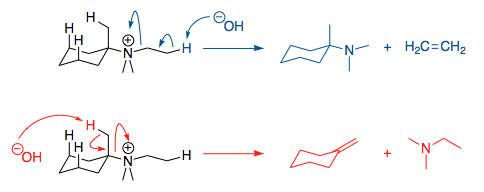In my Chemistry class, we were given this question to solve, and I'm not sure I fully understood the solution.
I understand that since the substrate is bulky, Saytzeff elimination can't happen, so it has to be Hofmann. What I don't understand is how it happens here. Where does the base attack the substrate? Essentially, I'd like to know the mechanism of the reaction.
Also, our teacher made us write that had all three substituents on the nitrogen atom been methyls, Saytzeff elimination would have been followed as there wouldn't have been any other choice. However, even if all three substituents were methyls, wouldn't the substrate still be bulky? Why would it follow Saytzeff elimination?



